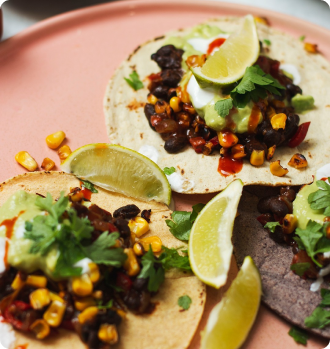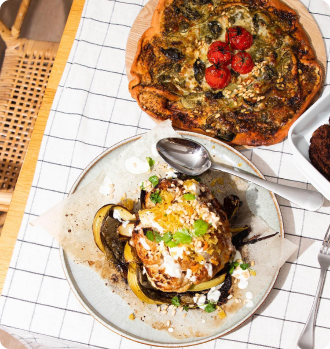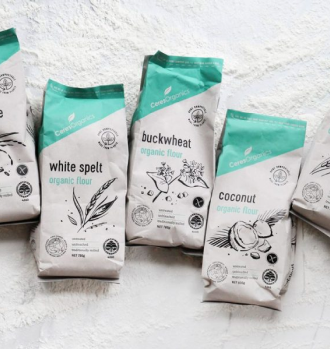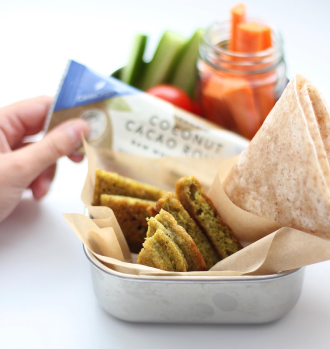
It’s completely possible to create delicious food, with ample flavour and character, without relying on highly processed sugar. Here's a little inspo for you.
One of the best ways to either reduce or avoid sugar is to make food yourself, from wholefood ingredients, organic where possible. In our ebook, Low Sugar Wholefood Nourishment we included some useful info on refined and unrefined sugars which you will also find below.
These following wholefood sugars are the least processed, but also contain vitamins, minerals, and other nutrients. So you’ll get your sweet fix, while enjoying some great benefits too.
Dates
Known for holding together bliss balls and raw torte crusts, dates are a completely natural and unrefined source of sugar. Dates have a pretty complex sugar composition makes them an energy-rich food. They're also pretty nutrient-dense, containing minerals like calcium, iron, phosphorus, copper and manganese.
Dates are one of Dr Libby’s preferred sweeteners. As Dr Libby states, “dates give food a lovely caramel flavour and if a recipe contains five dates and it serves 30, that’s not a lot of sugar per serve”. That is not to say they don't contain sugar, they do. Also, drying fruit removes the water, concentrating the sugars, so go easy. You don't need much to achieve a sweetness of flavour.
Brown rice malt syrup
As the name suggests, brown rice malt syrup is made from fermented cooked brown rice. During this process, enzymes break down the rice starches, producing smaller, more easily digested sugars.
Brown rice malt syrup is also a complex carbohydrate - a combination of glucose and maltose. This makes brown rice malt completely fructose free. It's for this reason brown rice malt is the preferred sweetener of Sarah Wilson (I Quit Sugar author). As a slow releasing sugar, it doesn’t load the liver and cause the stress other sugars can. You also don’t need to use much of it to achieve sweetness in your baking.
Coconut sugar and coconut nectar
Both of these sweeteners are made from the sweet sap of the coconut blossom. They are just processed slightly differently. With coconut nectar, the sap is evaporated at low temperatures producing a raw syrup, while coconut sugar is boiled down and concentrated, producing sugar granules.
For the most part, these coconut sweeteners are sucrose (about 70-80%), followed by smaller amounts of glucose and fructose. Minimally processed, they have the same nutritional profile you'll find in the coconut flower.
So, like other unrefined sweeteners, they offer small amounts of minerals, most notably iron, calcium, zinc and potassium - as well as some short-chain fatty acids and antioxidants. And with their low glycemic index, it's a slow and sustained energy release unlike what you’ll get from refined sugars.
Coconut sugar and nectar are also environmentally sustainable choices. As Ghandi once said “The juice of the coconut tree can be transformed into a sugar as soft as honey… nature created this product such that it could not be processed in factories.” Once you “tap” the tree, the sap can flow from it for another 20 or so years.
Still want to reduce sugar in your life? Here are some ingredients you'll probably have on hand that are going to bring the flavour and not the carbs!
Cinnamon
An aromatic spice with contrasting flavours, and more recently hailed for its powerful health benefits, cinnamon is not only a staple for baking, it can also be used to swap out sweeteners you’d otherwise add to your foods and hot drinks.
The ‘fire’ of cinnamon pairs wonderfully with cardamom, turmeric and ginger. The later of the two are often combined in immune and metabolism boosting tonics.
Ground cinnamon can be used directly in place of sugar. A teaspoon adds a subtle sweetness to tea or coffee, while offering a healthy alternative that won’t sacrifice flavour. Store your cinnamon in an airtight container in a cool, dry and dark place.
Cardamon
A perfumed, sharp, citrus-like spice, cardamom has an intense sweet flavour that, like other spices, can be used whole or ground. Pinches of the potent spice work equally well in savoury dishes, such as dhal, or in desserts to add flavour, reducing the requirement for added sugar.
Where possible, buy green cardamom pods instead of ground cardamom. Cardamom in its whole form stays potent for much longer. You can very easily grind the seeds nestled inside the pod with a mortar and pestle.
The complex flavour of cardamom works wonderfully alone to enhance dishes. It also pairs perfectly with cinnamon, ginger, cloves, cashews, almonds and coconut.
Raw maca powder
Maca root is an adaptogen with ‘superfood’ status. It’s known to balance hormones, boost energy levels, and promote good health in general. Once harvested, the root is ground down into a powder. Maca has a distinct caramel, butterscotch-like flavour, and is generally purchased in a dried powder form. There are endless other ways to incorporate maca into your day. Stir through your overnight oats, or add a teaspoon into raw treats.
With big flavour, maca can be an acquired taste, yet it pairs wonderfully with cacao and vanilla. However, we suggest building up your maca tolerance as it is a powerful substance – adding a teaspoon to your daily smoothie is all you need to reap the benefits.
Raw cacao powder
You’ve no doubt heard of the unique health benefits of consuming cocoa, which is great news for chocolate lovers. Of course the less processed the cocoa the better, with raw cacao being the ideal choice.
The key difference between raw cacao and cocoa is in the processing. Raw cacao is the purest form of chocolate you can get. Minimally processed, it retains much of its inherent nutrient profile including, monounsaturated fats, vitamins, minerals, dietary fibre, protein and good carbs, making it a nutrient-dense food. Cocoa refers to the heated, more processed form of cacao.
Raw cacao does have a slight bitterness that might take some getting used to, but the intense rich chocolate flavour it provides can still give you that chocolate fix when you need it. A mug of hot chocolate combining cacao with warming spices, such as cinnamon and cayenne, works to heat your body from the inside out, and is a healthy way to satisfy a sweet tooth.
Organic matcha powder
Matcha is a potent superfood, obtained by milling whole green tea leaves into a powder. Unlike other green tea, with matcha you consume the whole leaf, so one serve can offer the benefits of about 10 cups of steeped green tea.
Chlorophyll and amino acids give matcha its unique rich taste - initially vegetal, followed by a lingering sweetness. Much like maca or raw cacao, it can take some getting used to, so start small. However, when paired with other flavours, the taste becomes more subtle.
If you struggle to maintain your energy levels throughout the afternoon, and end up snacking on processed, refined carbohydrates, try mixing matcha with coconut water and lime for a delicious, energising drink to help curb sugar cravings. Adding a teaspoon to your smoothie, or incorporating into chia puddings, bliss balls and nut milks, are also great ways to reap the benefits of matcha daily.
Ginger Powder
While fresh ginger may not always be readily available, the ground version of this aromatic, spicy root is easy to source all year round. Processing alters the nutrient profile somewhat, reducing the amount of the active ingredient gingerol, but ground ginger still offers up high levels of antioxidants, and other health-promoting compounds.
Spices often play an underestimated role in our diets, and ginger has both protective and restorative properties, so it’s a great spice to incorporate into your diet where you can.
Try adding half a teaspoon of ginger to smoothies, or pairing with cinnamon and vanilla in your oats or Bircher. It will not only add a warm, zesty flavour, but you’ll be less likely to need sweetener.
Vanilla
This aromatic flavouring is actually derived from orchids in the genus Vanilla, native to Mexico. Though vanillin is the primary chemical component responsible for the unique aroma of vanilla beans, they contain several hundred other minor compounds, all of which add complexity to the aroma.
If you’re wanting a delicious way to provide a natural mood boost, or get you through the 3 o’clock slump, vanilla could be your ingredient. Whether you choose vanilla extract, powdered vanilla or whole beans, a little gives a lot of benefit. We’ve added vanilla to sweeten this Chia Persimmon Pudding.
Similarly, add vanilla in your overnight oats or porridge, and you’ll no longer miss that drizzle of maple syrup or honey. A half teaspoon or so added to smoothies or raw treats.
Recipes throughout this article are taken from our latest ebook, Low Sugar Wholefood Nourishment. This 54-page digital publication features 15 delicious, easy to make, Instagram worthy sweet treat recipes – without all the sugar!

















